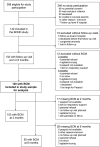Early weight gain trajectories and body composition in infancy in infants born very preterm
- PMID: 33205622
- PMCID: PMC8244114
- DOI: 10.1111/ijpo.12752
Early weight gain trajectories and body composition in infancy in infants born very preterm
Abstract
Background: Concerns are raised about the influence of rapid growth on excessive fat mass (FM) gain in early life and later cardiometabolic health of infants born preterm.
Objectives: To study the association between postnatal weight gain trajectories and body composition in infancy in infants born very preterm.
Methods: In infants born <30 weeks gestation, we evaluated associations between weight Z-score trajectories for three consecutive timeframes (NICU stay, level-II hospital stay and at home) and body composition, measured at 2 and 6 months corrected age by air-displacement plethysmography.
Results: Of 120 infants included, median gestational age at birth was 27+5 (interquartile range 26+1 ;28+5 ) and birth weight 1015 g (801;1250). The majority of infants did not make up for their initial loss of weight Z-score, but growth and later body composition were within term reference values. Weight gain during NICU stay was not associated with fat mass (absolute, %FM or FM index) in infancy. Weight gain during NICU and level II hospital stay was weakly associated with higher absolute lean mass (LM), but not after adjustment for length (LM index). Weight gain in the level-II hospital was positively associated with fat mass parameters at 2 months but not at 6 months. Strongest associations were found between weight gain at home and body composition (at both time points), especially fat mass.
Conclusions: Weight gain in different timeframes after preterm birth is associated with distinct parameters of body composition in infancy, with weight gain at home being most strongly related to fat mass.
Keywords: PEAPOD; air-displacement plethysmography; fat mass; lean mass.
© 2020 The Authors. Pediatric Obesity published by John Wiley & Sons Ltd on behalf of World Obesity Federation.
Conflict of interest statement
No conflict of interest was declared.
Figures


Similar articles
-
Body Composition Trajectories From Infancy to Preschool in Children Born Premature Versus Full-term.J Pediatr Gastroenterol Nutr. 2017 Jun;64(6):e147-e153. doi: 10.1097/MPG.0000000000001494. J Pediatr Gastroenterol Nutr. 2017. PMID: 28045768
-
Lean Tissue Deficit in Preterm Infants Persists up to 4 Months of Age: Results from a Swedish Longitudinal Study.Neonatology. 2020;117(1):80-87. doi: 10.1159/000503292. Epub 2019 Dec 10. Neonatology. 2020. PMID: 31822002
-
An observational cohort study of weight- and length-derived anthropometric indicators with body composition at birth and 5 mo: the Healthy Start study.Am J Clin Nutr. 2017 Aug;106(2):559-567. doi: 10.3945/ajcn.116.149617. Epub 2017 Jun 28. Am J Clin Nutr. 2017. PMID: 28659296 Free PMC article.
-
Fat and Fat-Free Mass of Preterm and Term Infants from Birth to Six Months: A Review of Current Evidence.Nutrients. 2020 Jan 21;12(2):288. doi: 10.3390/nu12020288. Nutrients. 2020. PMID: 31973218 Free PMC article. Review.
-
Growth patterns and body composition in former extremely low birth weight (ELBW) neonates until adulthood: a systematic review.Eur J Pediatr. 2020 May;179(5):757-771. doi: 10.1007/s00431-019-03552-z. Epub 2020 Jan 4. Eur J Pediatr. 2020. PMID: 31901983
Cited by
-
In-hospital growth and long-term neurodevelopmental outcomes of very low birth weight infants.Front Pediatr. 2023 May 11;11:1180068. doi: 10.3389/fped.2023.1180068. eCollection 2023. Front Pediatr. 2023. PMID: 37252047 Free PMC article.
-
Contemporary definitions of infant growth failure and neurodevelopmental and behavioral outcomes in extremely premature infants at two years of age.J Perinatol. 2024 Jun;44(6):811-818. doi: 10.1038/s41372-023-01852-9. Epub 2024 Jan 9. J Perinatol. 2024. PMID: 38195921 Free PMC article.
-
Standardizing Neonatal Body Composition Assessment Using Air Displacement Plethysmography: Insights from the Bavarian Experience.Children (Basel). 2025 Jun 4;12(6):733. doi: 10.3390/children12060733. Children (Basel). 2025. PMID: 40564691 Free PMC article.
-
Sleep and 24-hour rhythm characteristics in preschool children born very preterm and full term.J Clin Sleep Med. 2023 Apr 1;19(4):685-693. doi: 10.5664/jcsm.10408. J Clin Sleep Med. 2023. PMID: 36661086 Free PMC article.
-
Maternal asthma in relation to infant size and body composition.J Allergy Clin Immunol Glob. 2023 Aug;2(3):100122. doi: 10.1016/j.jacig.2023.100122. Epub 2023 May 30. J Allergy Clin Immunol Glob. 2023. PMID: 37485032 Free PMC article.
References
-
- Su BH. Optimizing nutrition in preterm infants. Pediatr Neonatol. 2014;55(1):5‐13. - PubMed
-
- Ehrenkranz RA, Dusick AM, Vohr BR, Wright LL, Wrage LA, Poole WK. Growth in the neonatal intensive care unit influences neurodevelopmental and growth outcomes of extremely low birth weight infants. Pediatrics. 2006;117(4):1253‐1261. - PubMed
-
- Ruys CA, Hollanders JJ, Bröring T, et al. Early‐life growth of preterm infants and its impact on neurodevelopment. Pediatr Res. 2019;85:283‐292. - PubMed
-
- Guellec I, Lapillonne A, Marret S, et al. Effect of intra‐ and extrauterine growth on long‐term neurologic outcomes of very preterm infants. J Pediatr. 2016;175:93‐99. - PubMed
-
- American Academy of Pediatrics, Committee on Nutrition . Nutritional needs of low‐birth‐weight infants. Pediatrics. 1977;60(4):519‐530. - PubMed
MeSH terms
LinkOut - more resources
Full Text Sources

